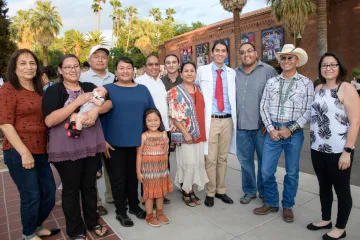Justin Kaye, PSM, MS: ‘I wanted to be an all-around doctor’
The Pre-Medical Admissions Pathway (P-MAP) fueled a student’s path from the Navajo Nation to medical school, to residency in California — and perhaps someday back to the Navajo Nation.

Justin Kaye, PSM, MS, and Allie Min, MD, at the White Coat Ceremony
Justin Kaye, PSM, MS, a member of the Hopi and Navajo tribes, grew up in Tuba City on the western edge of the vast Navajo reservation. As a child, Kaye joined his uncle and older cousin, both hatááłii, or traditional Navajo medicine men, to call on tribal members in need.
“That interaction they had with the families was really inspiring. You could tell the families really had trust in them, and they had a say in their care,” Kaye recalls.

Justin Kaye, PSM, MS, and his family at the White Coat Ceremony
When Kaye was an undergraduate student at the University of New Mexico, he attended an Association of American Indian Physicians conference, where the prospect of becoming a doctor became a real possibility for him.
“Seeing all the Native physicians, all the medical students, was a breath of fresh air,” he recalls. “They had similar backgrounds as me, coming from a small community in a rural town. I was like, ‘Wow, maybe I can go into medicine.’”
At the conference, Kaye learned about P-MAP (Pre-Medical Admissions Pathway), an intensive medical school preparation program the College of Medicine – Tucson built for promising students who have faced considerable obstacles. He was accepted into the program, where he met students with similar backgrounds. They became a tight-knit group who supported each another as they prepared for, and ultimately entered, medical school.
His childhood on the Navajo nation helped shape his decision as a med student to pursue the Rural Health Professions distinction track, which took him to hospitals and clinics in small towns across Arizona.
“That experience really solidified what I wanted to do,” he recalls. “I wanted to be an all-around doctor and get to really know my community well.”

Justin Kaye, PSM, MS, matched to a residency program in internal medicine at Highland Hospital in Oakland, California
Kaye’s experience with the Commitment to Underserved People (CUP) program, a student-run free clinic, also prepared him to reach his goals.
“Having that opportunity to serve patients and think about unique ways to give care in limited-resource settings was wonderful to do as a med student,” he says.
He also honed his leadership skills through his involvement with the Association of Native American Medical Students. Along with other members of his campus group, Kaye developed a land acknowledgement statement that now appears in the Health Sciences Innovation Building.
“The statement is a way to connect with Native students aspiring to become physicians, pharmacists, public health leaders and biomedical scientists, showing them, ‘You’re welcome here. You’re supported.’ That was our call to the Native students who are thinking about becoming physicians or going into the health sciences.”
Kaye is excited to begin his residency in internal medicine at Highland Hospital in Oakland, California. Despite being in an urban center, he believes the safety-net hospital will prepare him to compassionately treat similarly underserved rural patients — which is his goal for his career after residency.
“I’m definitely going to return to the Navajo nation,” he says.

